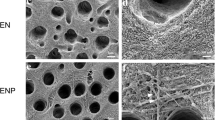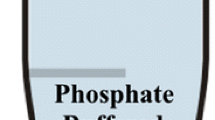Abstract
Objectives
To investigate the effectiveness of root canal irrigation with chitosan on the dislocation resistance of a root canal sealer (MTA Fillapex) in vitro, measured by the push-out bond strength test.
Materials and methods
Root canals of mandibular premolars (n = 57) were prepared using rotary files with 5.25% sodium hypochlorite as the irrigant during instrumentation. Following this, the specimens were randomly divided into three groups (n = 19) based on the final irrigant: group 1, 0.2% chitosan solution; group 2, 17% EDTA solution; group 3, saline. Three specimens from each group were analyzed using scanning electron microscopy-energy dispersive spectroscopy (SEM-EDS). The remaining specimens of each group were divided into two subgroups (n = 8) based on the method of agitation of the final irrigants (chitosan/EDTA/saline): subgroup A, sonic (Endoactivator, Dentsply Maillefer); subgroup B, no activation (control). After irrigation, all specimens obturated with a commercial mineral trioxide aggregate-resin hybrid sealer (MTA Fillapex, Angelus, Londrina, Brazil). Dislocation resistance was measured using the push-out bond strength test after 3 weeks. The data were analyzed using Kruskal-Wallis test (P = 0.05).
Results
Immaterial of the irrigant agitation, groups irrigated with chitosan showed significantly higher bond strength values than those irrigated with EDTA (P < 0.05). Groups irrigated with saline showed the least bond strength values (P < 0.05). When EDTA was used, sonic agitation significantly improved the bond strength of the sealer, compared to the control (P < 0.05). There was no significant difference between sonic agitation and the control when chitosan solution was used as the final irrigant (P > 0.05). The nitrogen/carbon ratio was significantly higher in chitosan groups compared to the control group (P < 0.05).
Conclusion
This study provides the first evidence that chitosan irrigation improves the dislocation resistance of MTA-resin hybrid root canal sealer, compared to EDTA and saline irrigation.
Clinical relevance
Chitosan-based irrigation has been previously shown to demonstrate anti-biofilm properties in the root canal. The present study demonstrates that chitosan can improve the bond strength of a root filling material, which may contribute to better sealing of the root canal system.

Similar content being viewed by others
References
Caron G, Nham K, Bronnec F, Machtou P (2010) Effectiveness of different final irrigant activation protocols on smear layer removal in curved canals. J Endod 36:1361–1366
Khedmat S, Shokouhinejad N (2008) Comparison of the efficacy of three chelating agents in smear layer removal. J Endod 34:599–602
Torabinejad M, Handysides R, Khademi AA, Bakland LK (2002) Clinical implications of the smear layer in endodontics: a rewiew. Oral Surg Oral Med Oral Pathol Oral Radiol Endod 94:658–666
Gu L, Kim JR, King J, Choi KK, Pashley DH, Tay FR (2009) Review of contemporary irrigant agitation techniques and devices. J Endod 35:791–804
Shahravan A, Haghdoost AA, Adl A, Rahimi H, Shadifar F (2007) Effect of smear layer on sealing ability of canal obturation: a systematic review and meta-analysis. J Endod 33:96–105
Spanó JCE, Silva RG, Guedes DFC, Sousa-Neto MD, Estrela C, Pécora JD (2009) Atomic absorption spectrometry and scanning electron microscopy evaluation of concentration of calcium ions and smear layer removal with root canal chelators. J Endod 35:727–730
Kuah HG, Lui JN, Tseng PS, Chen NN (2009) The effect of EDTA with and without ultrasonics on removal of the smear layer. J Endod 35:393–396
Torabinejad M, Khademi A, Babagoli J (2003) A new solution for the removalof the smear layer. J Endod 29:170–175
Kishen A, Shrestha S, Srestha A, Chengc C (2016) Characterizing the collagen stabilizing effect of crosslinked chitason nanoparticles against collagenase degradation. Dental Mat 32:968–977
Peter MG (1995) Applications and environmental aspects of chitin and chitosan. J Macromol Sci A 32:629–640
Carpio-Perochena AD, Bramante CM, Duarte MAH, de Moura MR, Aouada FA, Kishen A (2015) Chelating and antibacterial properties of chitosan nanoparticles on dentin. Restor Dent Endod 40:195–201
Silva P, Guedes D, Nakadi F, Pecora J, Cruz-Filho A (2013) Chitosan: a new solution for removal of smear layer after root canal instrumentation. Int Endod 46:332–338
Bolles JA, He J, Svoboda KKH, Scheinderman E, Glickman GN (2013) Comparison of Vibringe, EndoActivator, and needle irrigation on sealer penetration in extracted human teeth. J Endod 39:708–711
Torres DU, Gonzalez-Rodrıguez MP, Ferrer-Luque CM (2010) Effectiveness of the EndoActivator system in removing the smear layer after root canal instrumentation. J Endod 36:308–311
Neelakantan P, Ahmed HMA, Wong MCM, Matinlinna JP, Cheung GSP (2018) Effect of root irrigation protocols on the disclocation resistance of mineral trioxide aggregate-based materials: a systematic review of laboratory studies. Int Endod J 51:847–861
Oliveira DS, Cardoso ML, Queiroz TF, Silva EJ, Souza EM, De-Deus G (2016) Suboptimal push-out bond strenghts of calcium silicate-based sealers. Int Endod J 49:796–801
Madhusudhana K, Satyavathi E, Lavanya A, Suneelkumar C, Deepthi M (2015) Research article comparison of the effect of chitosan and morindacitrifolia on smear layer removal: an in vitro study. Sch J Dent Sci 2:132–136
Neelakantan P, Nandagopal M, Shemesh H, Wesselink P (2015) The effect of root dentine conditioning protocols on the push-out bond strength of three calcium silicate sealers. Int J Adhes Adhes 60:104–108
Reddy P, Neelankantan P, Sanjee K, Matinlinna J (2018) Effect of irrigant neutralizing reducing agents on the compromised dislocation resistance of an epoxy resin and a methacrylate resin-based root canal sealer in vitro. Int J Adhes Adhes 82:206–210
Silva PV, Guedes DF, Pécora JD, Cruz-Filho AM (2012) Time-dependent effects of chitosan on dentin structures. Braz Dent J 23:357–361
Gusiyska A, Dyulgerova E, Vassileva R, Gyulbenkiyan E (2016) The effectiveness of chitosan-citrate solution to remove the smear layer in root canal treatment-an in-vitor study. Int J Sci Res 5:1169–1174
Bitter K, Meyer-Lueckel H, Priehn K, Kanjuparambil JP, Neumann K, Kielbassa AM (2006) Effects of luting agent and thermocycling on bond strengths to root canal dentine. Int Endod J 39:809–818
Ururahy MS, Curylofo-Zotti FA, Galo R, Nogueira LFB, Ramos AP, Corona SAM (2017) Wettability and surface morphology of eroded dentin treated with chitosan. Arch Oral Biol 75:68–73
Shrestha A, Fong SW, Khoo BC, Kishen A (2009) Delivery of antibacterial nanoparticles into dentinal trubules using high-intensity focused ultrasound. J Endod 35:1028–1033
Gu LS, Cai X, Guo JM, Pashley DH, Breschi L, Xu HHK, Wang XY, Tay FR, Niu LN (2018) Chitosan-based extrafibrillar deminerilization for dentin bonding. J Dent Res 98:186–193. https://doi.org/10.1177/0022034518805419. [Epub ahead of print
Gu L, Mazzoni A, Gou Y, Pucci C, Breschi L, Pashley DH, Niu L, Tay FR (2018) Zymography of hybrid layers created using extrafibrillar demineralization. J Dent Res 97:409–415
Mancini M, Cerroni L, Iorio L, Armellin E, Conte G, Cianconi L (2013) Smear layer removal and canal cleanliness using different irrigation systems (EndoActivator, EndoVac, and passive ultrasonic irrigation): field emission scanning electron microscopic evaluation in an in vitro study. J Endod 39:1456–1460
Niu LN, Luo XJ, Li GH, Bortoluzzi EA, Mao J, Chen JH, Gutmann JL, Pashley DH, Tay FR (2014) Effects of different sonic activation protocols on debridement efficacy in teeth with single-rooted canals. J Dent 42:1001–1009
Reyes-Carmona JF, Felippe MS, Felippe WT (2009) Biomineralization ability and interaction of mineral trioxide aggregate and white Portland cement with dentine in a phosphate-containing fluid. J Endod 35:731–736
Sarkar NK, Caicedo R, Ritwik P, Moiseyeva R, Kawashima I (2005) Physicochemical basis of the biologic properties of mineral trioxide aggregate. J Endod 31:97–100
Govindaraju L, Neelakantan P, Gutmann JL (2017) Effect of root canal irrigating solutions on the compressive strength of tricalcium silicate cements. Clin Oral Investig 21:567–571
Kesim B, Burak AK, Ustun Y, Delikan E, Gungor A (2018) Effect of chitosan on sealer penetration into the dentinal tubules. Niger J Clin Pract 21:1284–1290
Author information
Authors and Affiliations
Corresponding author
Ethics declarations
Conflict of interest
Esin Ozlek declares that she has no conflict of interest. Priti Pragati Rath declares that she has no conflict of interest. Anil Kishen declares that he has no conflict of interest. Prasanna Neelakantan declares that he has no conflict of interest.
Ethical approval
All procedures performed in studies involving human participants were in accordance with the ethical standards of the institutional and/or national research committee and with the 1964 Helsinki declaration and its later amendments or comparable ethical standards. The use of extracted teeth was approved by the Institutional Review Board and Ethics committee of The University of Yuzuncu Yil.
Informed consent
For this type of study, formal consent is not required.
Additional information
Publisher’s note
Springer Nature remains neutral with regard to jurisdictional claims in published maps and institutional affiliations.
Rights and permissions
About this article
Cite this article
Ozlek, E., Rath, P.P., Kishen, A. et al. A chitosan-based irrigant improves the dislocation resistance of a mineral trioxide aggregate-resin hybrid root canal sealer. Clin Oral Invest 24, 151–156 (2020). https://doi.org/10.1007/s00784-019-02916-x
Received:
Accepted:
Published:
Issue Date:
DOI: https://doi.org/10.1007/s00784-019-02916-x




